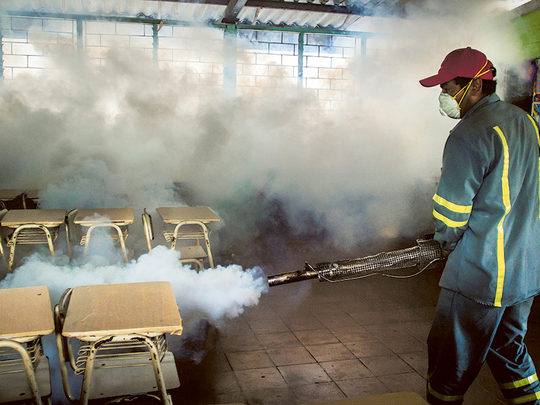
Every weekday at 7am, a van drives slowly through the southeastern Brazilian city of Piracicaba carrying a precious cargo — mosquitoes. More than 100,000 of them are dumped from plastic containers out the van’s window, and they fly off to find mates.
But these are not ordinary mosquitoes. They have been genetically engineered to pass a lethal gene to their offspring, which die before they can reach adulthood. In small tests, this approach has lowered mosquito populations by 80 per cent or more.
The biotech bugs could become one of the newest weapons in the perennial battle between humans and mosquitoes, which kill hundreds of thousands of people a year by transmitting malaria, dengue fever and other devastating diseases and have been called the deadliest animal in the world.
“When it comes to killing humans, no other animal even comes close,” Bill Gates, whose foundation fights disease globally, has written.
The battle has abruptly become more pressing by what the World Health Organisation has called the “explosive” spread of the mosquito-borne Zika virus through Brazil and other parts of Latin America.
Experts say that new methods are needed because the standard practices — using insecticides and removing the standing water where mosquitoes breed — have not proved sufficient.
“After 30 years of this kind of fight, we had more than 2 million cases of dengue last year in Brazil,” said Dr. Artur Timerman, an infectious disease expert in Sao Paulo. “New approaches are critically necessary.”
But the new efforts have yet to be proved, and it would take some years to scale them up to a meaningful level. An alternative to mosquito control, a vaccine against Zika, is not expected to be available soon.
So for now, experts say, the best modes of prevention are to intensify use of the older methods of mosquito control and to lower the risk of being bitten using repellents and by wearing long sleeves.
Women are being advised to not get pregnant and to avoid infested areas if pregnant, since the virus is strongly suspected of causing babies to be born with abnormally small heads and damaged brains.
One old method that is not getting serious attention would be to use DDT, a powerful pesticide that is banned in many countries because of the ecological damage documented in the 1962 book “Silent Spring.” Still, it is being mentioned a bit, and some experts defend its use for disease control.
“That concern about DDT has to be reconsidered in the public health context,” said Dr. Lyle R. Petersen, director of the division of vector-borne diseases at the Centers for Disease Control and Prevention. He said the damage to fish and wildlife stemmed from widespread outdoor use of DDT in agriculture, not the use of small amounts on walls inside homes to kill mosquitoes.
Other experts say the old methods can work if applied diligently.
“We’ve had great success using old methods for the last 50, 60 years,” said Dr. Peter J. Hotez, dean of the National School of Tropical Medicine at the Baylor College of Medicine. “We just need to be very aggressive and exercise political will.”
The main mosquito that transmits Zika virus — and also dengue, chikungunya and yellow fever — is Aedes aegypti, a particularly wily foe.
It prefers urban areas and bites mainly people, making it very efficient at spreading disease. It bites in the day, so bed nets, a common way to protect people against the night-biting malaria mosquitoes, have little effect. It breeds in small containers of water, such as flower pots, cans and tires that collect rainwater.
“I’ve seen Aedes aegypti merrily breeding in discarded soda caps,” said Joseph M. Conlon, technical adviser to the American Mosquito Control Association.
Aedes aegypti is found in the southern part of the United States, so public health authorities say there will be some local transmission of Zika in this country, though it will be far less serious than in Latin America. Petersen of the CDC said he envisioned “almost a SWAT team approach” in which resources would be rapidly deployed to areas of local transmission to control mosquitoes using conventional methods.
The genetically engineered Aedes aegypti mosquitoes were developed by Oxitec, a British company, to fight dengue, but would also work to curtail the spread of Zika.
Since April, the mosquitoes have been released in one neighbourhood of Piracicaba populated by about 5,000 people. By the end of 2015, there was a reduction in wild mosquito larvae — as opposed to larvae inheriting the lethal gene — of 82 per cent, the company said.
But critics worry about the long-term effects of releasing genetically modified organisms. Oxitec has run into public opposition to a proposed test in the Florida Keys.
A Brazilian commission that oversees genetically engineered organisms declared the Oxitec mosquitoes safe to release into the environment in 2014. But Oxitec still does not have a license from Brazil’s health regulators that would allow it to actively market its approach to Brazilian cities.
Still, said Hadyn Parry, the company’s chief executive, with the outbreak of Zika, “We’ve had a huge amount more interest from different municipalities.”
Another approach, being tested in one Rio de Janeiro neighbourhood, is to infect the mosquitoes with Wolbachia, a bacterium that does not infect them naturally. Once infected, the mosquitoes do not pick up and transmit viruses as easily.
The bacteria can be passed to the next generation through eggs, so they spread through the mosquito population.
“The beauty of it is it is a sustainable method — once you put it out it sustains itself in the environment and gives ongoing protection,” said Scott O’Neill, dean of science at Monash University in Australia. He is the leader of Eliminate Dengue, a Wolbachia project supported by the Bill & Melinda Gates Foundation and others.
— New York Times News Service












